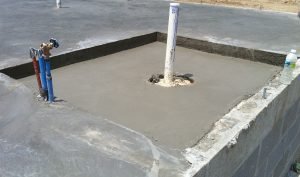What is Sunken Slab? its 5 Construction Steps, Uses, & Advantages
The sunken slab is a type of slab provided to maintain architectural design in areas where water drainage systems or pipes are installed below the floor or tiles such as in the washroom, as well as laundry areas.
Below the normal floor level, the sunken slab is cast at certain depth as 200mm or 300mm or any other depending on the design and for placing pipes and utility ducts this extra depth is used. Then until the normal floor level, space is filled with sand or other lightweight materials.

To provide an easy way to install sanitary products and built eye-catching views in those areas this system is accepted and also all pipe systems remain below the floor and extra care required while constructing a sunken slab.
To hide the sewage pipes or sewerage pipes these slabs are mostly used in washrooms and provided below the washrooms. In this type, the pipes which carry water are concealed below the floor and to avoid leakage problems special care has to be taken. The slab is filled with coal or broken pieces of bricks after casting sewage pipes in the slab.

By considering future visions related to the maintenance of those areas the kind of construction require well trained or experienced workers to tackle all aspects very well. To stay away from dampness problems in the future use plasticizer during construction.
Construction Method of Sunken Slab:
There are the following steps in the construction method of the sunken slab as given below;
- To get a denser watertight concrete, the concrete of R.C.C should be mixed with a waterproofing material.
- Then in water-cement and waterproofing material should be diluted and by using a mortar plasticizer with the cement mortar a layer of plaster should be provided.
- The floor should be done with cement mortar mixed with a mortar plasticizer and also the bricks of walls and plastering of the walls should be done.
- Walls tiles and tile fixing for the floor should be done with non-shrink and to make the tiled area waterproof, waterproof tiles are used.
- Finally, with sealants, sanitary pipe joints should be sealed so that no water can leak through it.
Material Used to Fill Sunken Slab:
Lightweight broken CLC blocks are used to fill the sunken slab and these blocks are the best alternative to Light Weight Cinder, Broken bricks, Brick Jelly, Coal lumps, Burnt Tar lumps, and AAC Blocks. It resumes to gain strength with time as long as some moisture is available in the environment and requires little maintenance and normally cured cement-based products.
Lightweight broken CLC blocks are the best alternative to;
- Broken Red clay Bricks
- Broken Fly Ash Bricks
- Light Weight Cinder
- Coal lumps
- Burnt Tar lumps &
- Brick Jelly
Uses of Sunken Slab:
There are the following uses of sunken slab such as;
- The sunken slab is used in room, toilet, latrine, and wash area floor and within the sunken portion, the floor trap and the drainage lines can be taken.
- In porch slabs, beams are inverted so a plain surface is available and the beams do not protrude downside.
- It is used in mid landing on a staircase where there is adequate headroom available below the landing because the end beam is designed as an inverted beam.
- In some unique architectural designs where sanitary arrangement takes place sunken slab is used.
Advantages of Sunken Slab:
There are the following advantages of sunken slab such as;
- All plumbing pipes are concealed inside the slab in this type of slab.
- To reduce noise during usage of the bathroom there is no need for special plumbing fixtures in the sunken slab.
- These slabs provide good plumbing systems and also used where security systems are to be installed.
- The sealing design is compromised and creates special ventilation.
Disadvantages of Sunken Slab:
There are also some disadvantages to this type of slab such as;
- The height is decreased in the slab in the sunken slab.
- This type of slab needs experience or skilled labor to construct.
- In this type of slab, waterproofing and brickbat take more time to construct.
We Love Cricket

